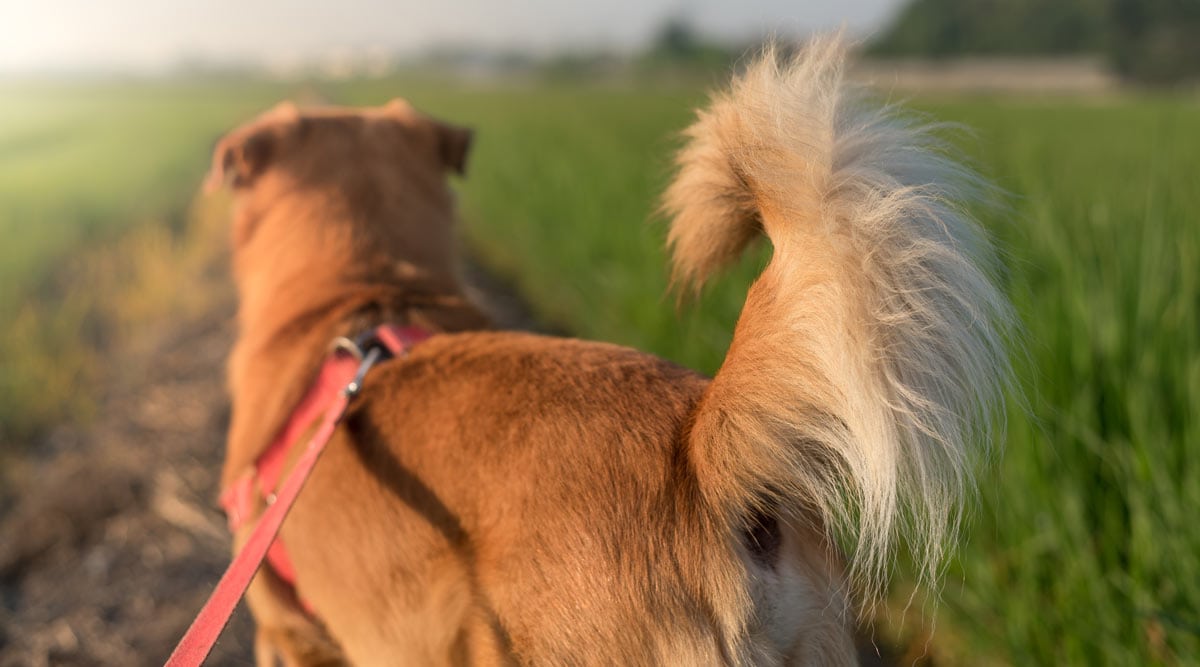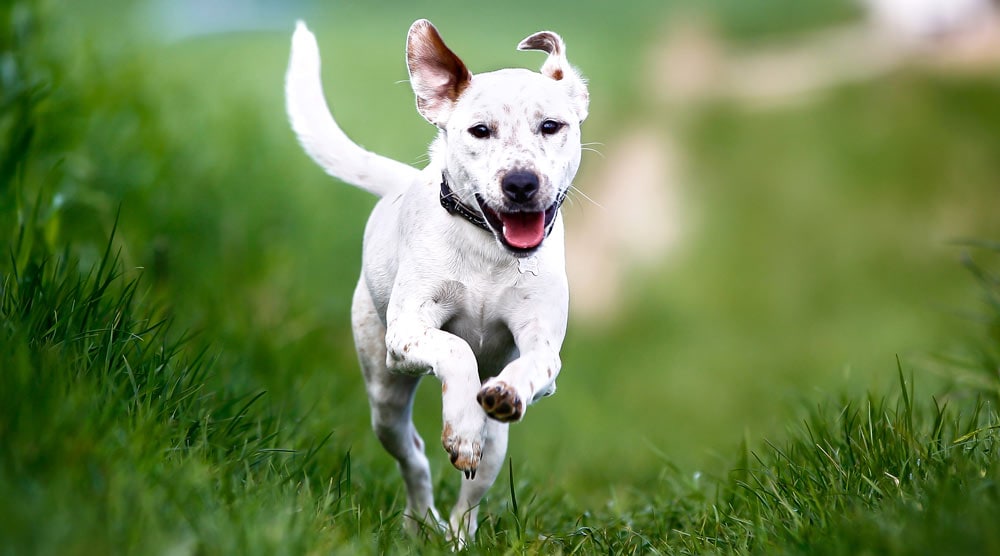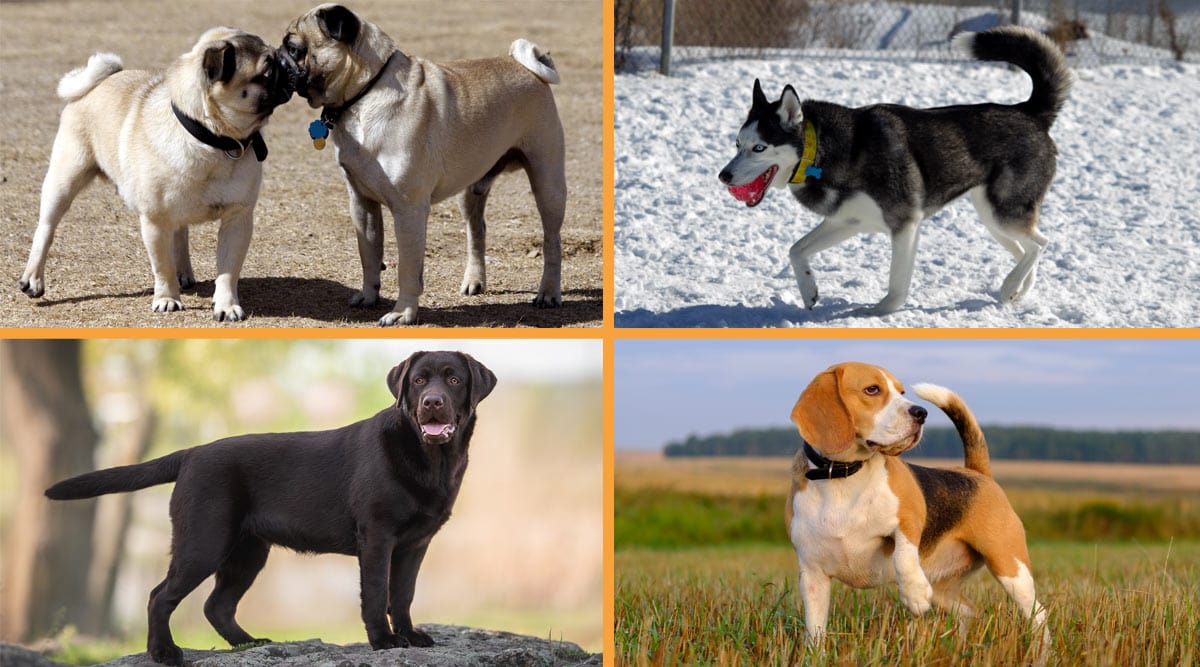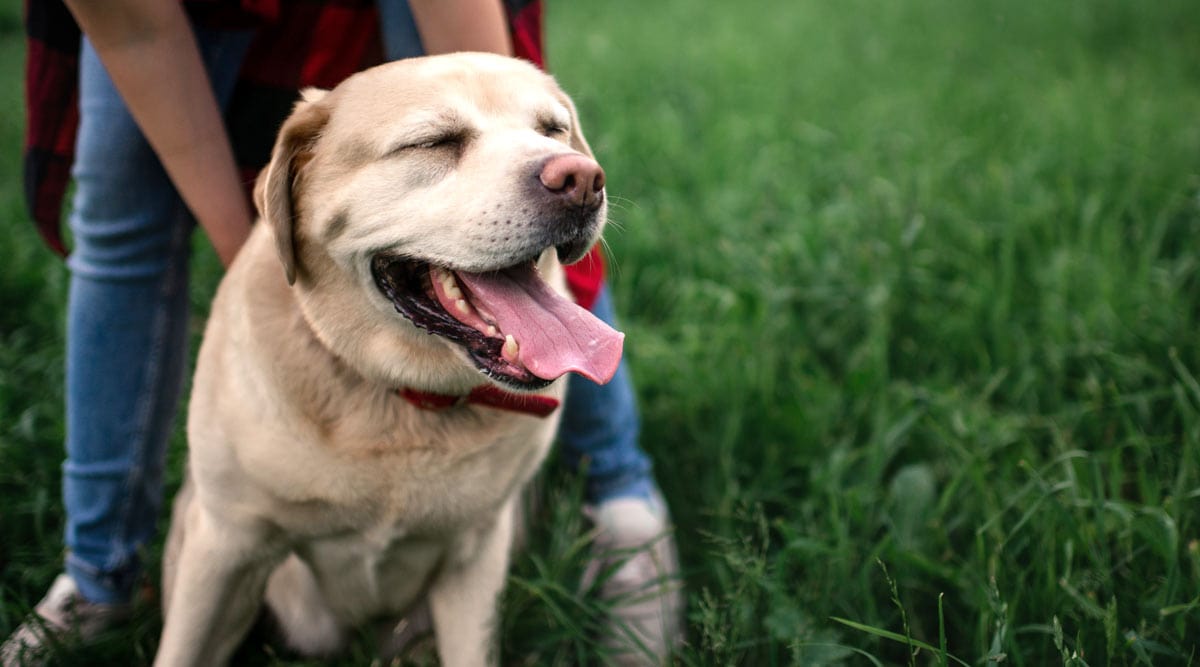Dogs experience a range of complex emotions, such as fear, stress, joy, and curiosity. While they can’t talk like humans, our four-legged friends are constantly broadcasting these emotions through their body language.
One of the most important components of canine body language is the tail. Despite what many people think, a wagging tail doesn’t always signal a happy dog. Instead, the tail’s position, stiffness, speed, and direction all affect dog tail meanings.
In this article, we’ll show you how to identify common dog tail positions and meanings. However, a dog’s tail is just one aspect of canine body language. To understand what your dog is trying to communicate, you also need to observe other factors, like ear position, posture, facial expression, and more.
Contents
- Does a Wagging Tail Mean a Dog is Happy?
- The Key Rules for Reading a Dog’s Body Language
- Dog Tail Positions – What Do They Mean?
- Dog Tail Stiffness and Wag Breadth – Is Your Dog’s Tail Rigid or Relaxed?
- Dog Tail Wag Speed – How Does It Affect a Displayed Emotion?
- Dog Tail Wag Direction – Left or Right?
- Putting It All Together: How to Identify Tail Meanings
- Relaxed – Neutral Position, Relaxed Tail, No (Or Little) Wagging
- Happy – Slightly Upright or Neutral Position, Relaxed Tail, Broad Wag
- Very Excited And Happy – Fast Wag in a Circular Motion (Helicopter Tail)
- Alert or Defensive – High Position, Stiff Tail, Narrow Wag
- Anxious – Low Position, Stiff Tail, Slow Wag
- Fearful – Tucked Position, Stiff Tail, Fast Wag
- Common Mistakes When Assessing Tail Meanings
Why Dogs Use Their Tails to Communicate
Before we get to dog tail meanings, a common question is why dogs use their tails to communicate.
Dogs have excellent vision for detecting movement. This allows them to pick up nuances in other dogs’ body language – with the tail being one of the most obvious body parts.
Over time, certain traits have emerged in dogs’ tails to enhance their communication capabilities. You might notice that some dog tails have different color tips, or are covered in a bushy coat. These features make the tail more visible to other dogs and humans alike.
On the other hand, dogs with very short or docked tails may struggle to communicate as effectively. This is just one of many reasons why The Dog Clinic strongly believes tail docking should never be practiced unless medically necessary.
Does a Wagging Tail Mean a Dog is Happy?
The simple answer is that a wagging tail doesn’t mean a dog is happy. Dogs wag their tails to express a variety of emotions, including stress, anxiety, and defensiveness, not just happiness.
For example, when a dog is feeling defensive and doesn’t want to be approached, it may hold its tail upwards and wag in a fast, narrow pattern. On the other hand, a scared dog may tuck its tail between its legs and wag it quickly.
As responsible dog parents, it’s our job to learn to recognise our pet’s body language. By doing so, we can build stronger bonds and ensure our dogs lead happier lives. Learn more about this topic in our guide to why dogs wag their tails.

The Key Rules for Reading a Dog’s Body Language
Understanding dog tail meanings can enhance your bond with your furry friend. But keep in mind that a little knowledge can be a dangerous thing!
Remember, a dog’s tail position is just one part of its body language. You can’t interpret a dog’s emotions just by observing the tail. Instead, pay attention to the dog’s overall movement, body language signals, and posture.
Additionally, context is vital. What’s happening around your dog? Could external factors, like illness or recent stress, be influencing their emotions? For example, happy tail syndrome or a broken tail could both cause a dog’s tail to hang.
“It takes a long time to become an expert in reading dogs because their signs can be so quick and subtle,” says dog trainer Rebecca Morello. “To help you understand the dog in front of you, look at the whole picture. This doesn’t just include what the dog looks like, but what is actually happening in the environment around them.”
“For example, a dog that is lying down with it’s tail curled under them yawning may just be tired. But if they have been in the same room as someone having an argument, this is their way of trying to diffuse the situation. ”
Dog breed and tail type are another consideration. Dogs with short or naturally curled tails are a challenge when it comes to reading tail signals. For these dogs, it’s even more important to observe the dog’s overall body language. You may also need to pay particular attention to the base of the tail in short-tail breeds.
Finally, never forget that each dog is unique. This uniqueness is part of why we love them so dearly, but it also makes interpreting canine body language more complex than you might think. So keep learning, observing, and loving your dog for the individual they are.
Dog Tail Positions – What Do They Mean?
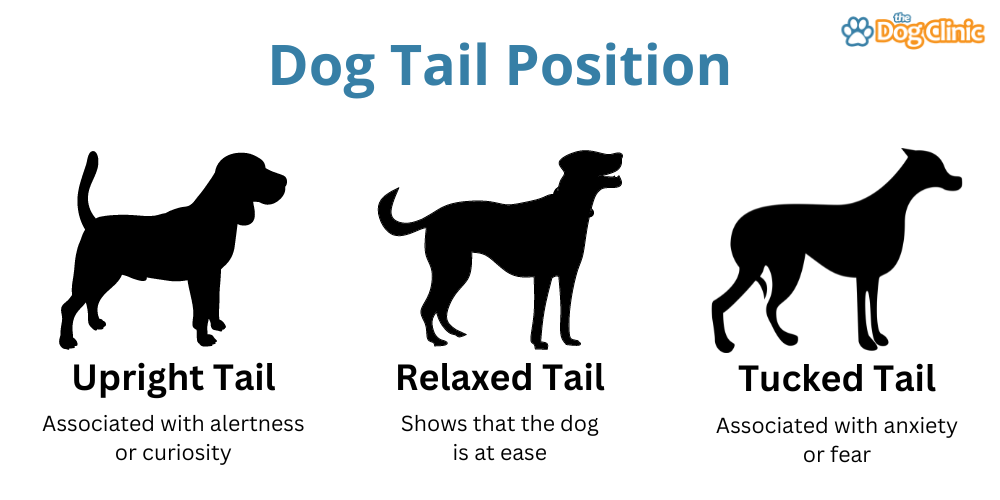
Dog tail meanings vary depending on a variety of factors, including:
- Tail position
- Tail stiffness
- Wag breadth
- Wag speed
- Wag direction
By combining each of these five factors, a dog can express a wide range of different emotions. We’re going to discuss each of these, but let’s start with the tail position.
The position of a dog’s tail hints at the type of emotion they’re feeling, such as anxiety, relaxation, or alertness.
However, these positions are only a general guide. They can vary depending on the breed and natural position of a dog’s tail. Tail positions can even be affected by the dog’s age, as puppies learn to express themselves as they grow.
Neutral or Relaxed
A neutral tail position often signifies a relaxed or content dog. But the caveat is that every dog breed has a different neutral position!
For example, a neutral tail may hang slightly down in breeds like the golden retriever. Alternatively, it might curl up in breeds like the pomeranian or pug.
Recognizing your dog’s neutral tail position is the first step to reading their tail-based communication. Without knowing your dog’s neutral position, it’s impossible to tell when the tail is raised or lowered.
This is also why you should be cautious when interacting with an unfamiliar dog. You may not know their neutral tail position, making it harder to interpret tail signals.
High or Upright
When a dog’s tail is high, it usually indicates confidence or heightened arousal. Sometimes referred to as “flagging,” this position can even cause the tail to curl over the back.
Depending on the context and other body language cues, a high tail might signify excitement, alertness, or even defensiveness.
For example, a high, relaxed wagging tail may signal contentment. In contrast, a stiff, high tail vibrating with quick movements might indicate tension.
Generally, the higher the tail, the stronger the emotion. But keep in mind that some breeds naturally carry their tails high over their backs, like basenjis, pugs, and Siberian huskies.
Low or Tucked
A low or tucked tail suggests that the dog is feeling fear or anxiety. Typically, the lower the tail, the more intense the fear.
Dogs with naturally curled tails might be unable to tuck their tails under. The base of the tail will still point noticeably below “neutral” though. There will also be other signs of anxiety, like lip licking, hunched posture, or ‘whale eye’.
Dog Tail Stiffness and Wag Breadth – Is Your Dog’s Tail Rigid or Relaxed?
Aside from tail position, a dog’s tail can wag in different ways. In particular, variations in tail stiffness and wag breadth can tell you about what your dog is feeling.
Rigid Tail and Narrow Wag
If you observe a tail that’s stiff and vibrating in a narrow range, this often signals that your dog is alert to something in their environment. It can even mean the dog is potentially defensive and may bite if approached.
Relaxed Tail and Broad Wag
On the flip side, a relaxed tail that swings in a wide arc is usually a sign of a happy dog.
When the dog is very excited, you might even witness their tail spinning in a “helicopter” motion.
Dog Tail Wag Speed – How Does It Affect a Displayed Emotion?
The speed of your dog’s tail wag is another important factor when assessing emotions. In many cases, the speed is linked to the intensity of a dog’s emotions.
Fast
Fast tail wags often suggest strong emotions or heightened arousal.
A relaxed tail that’s wagging broadly and swiftly typically indicates happiness. On the other hand, a fast, narrow wag that resembles a tail vibrating signals a highly alert or defensive state.
Slow
Conversely, a slow tail wag suggests a less intense emotion or a sense of insecurity. The exact feeling, however, depends on the dog’s other body language signals.
Dog Tail Wag Direction – Left or Right?
Intriguingly, the direction of your dog’s tail wag can also reflect their emotional state.
- A wag biased more towards the left suggests your dog might be experiencing negative or unpleasant emotions.
- A right biased wag, on the other hand, is usually associated with positive emotions.
This could be due to how brains work. The left hemisphere, which manages the right side of the body, is often linked with positive emotions.
Spotting the direction of a dog’s tail wag can be tricky. But with careful observation, you’ll often notice a consistent leaning towards one side more than the other.
Putting It All Together: How to Identify Tail Meanings
Below, we’ve discussed common tail wag meanings and how to spot them. But keep in mind that you should always consider other body language signals alongside tail movements.
Relaxed – Neutral Position, Relaxed Tail, No (Or Little) Wagging

A relaxed dog usually holds its tail in a neutral position. If the dog isn’t experiencing a strong emotion, then it may not wag its tail.
Other indications of a relaxed dog include:
- A relaxed body posture
- Neutral facial expression
- Ears in a natural position
- Eyes maintaining a normal shape
Happy – Slightly Upright or Neutral Position, Relaxed Tail, Broad Wag

A happy dog may have its tail in a neutral or slightly upright position. The tail will be relaxed, swaying broadly and moderately quickly. As the dog grows more excited, the tail wag may quicken.
Additional signs of a happy dog include:
- Wagging hips alongside the tail
- A relaxed, open-mouthed “grin”
- Relaxed body posture
- Relaxed eyes and ears
Very Excited And Happy – Fast Wag in a Circular Motion (Helicopter Tail)
A dog that’s extremely happy may wag its tail in a fast, circular motion, commonly referred to as a “helicopter” tail.
This expression of joy is typically seen during moments of heightened excitement. It’s usually reserved for enthusiastic greetings.
Alert or Defensive – High Position, Stiff Tail, Narrow Wag

A dog on alert may hold its tail high and stiff, known as “flagging.” This shows that the dog is prepared to react, if necessary.
Alert body language could be due to something that the dog is curious about, like a rabbit in the distance. But it could also indicate that the dog isn’t happy about something (or someone) in the nearby environment.
A slow tail that’s held upright shows that the dog is uncertain about the situation. As the tail’s speed increases, it could reflect defensiveness and a warning not to get closer. A highly aroused and alert dog may wag its tail so fast that it looks like it’s vibrating.
Other signs of an alert dog include:
- Stiff body posture (hips won’t wag with the tail)
- Ears held up
- Tense facial expression
- Hard eyes
- Raised hackles if the dog is defensive
Anxious – Low Position, Stiff Tail, Slow Wag

An anxious dog often holds its tail below the neutral position, performing a slow, narrow wag. The wag speed may increase as the emotion gets stronger.
Additional signs of an anxious dog include:
- Hunched posture
- Lip licking
- Yawning
- Pacing
- Whale eyes (whites of the eyes showing)
- Panting
- Averting gaze
- Moving away from the anxiety trigger
Fearful – Tucked Position, Stiff Tail, Fast Wag

A fearful dog usually holds its tail even lower than an anxious one, tucking it under the body. The tail will remain stiff, but the faster vibration signifies intense fear.
Always remember that a fearful dog might resort to biting if cornered. Give them space and try to remove whatever is causing the fear from the immediate environment.
Other body language signals of a fearful dog include:
- Lip licking
- Trembling
- Moving away
- Hunched posture
- Anxious urination
- Rolling on the back

Common Mistakes When Assessing Tail Meanings
Understanding canine tail positions is a useful skill for any dog owner. It’ll help you build a stronger bond, identify the cause of behavioural issues, and avoid situations that could stress your dog.
However, it’s easy to make mistakes when interpreting tail signals. Some of the most common errors include:
- Misinterpreting a wagging tail. As we’ve explored throughout this article, a wagging tail does not necessarily mean a happy dog. Instead, tails communicate a range of emotions, from happiness to fear.
- Overemphasizing the tail and not looking at the dog’s overall body language. The tail is just one part of the canine body language puzzle. Body posture, facial expression, ear position, and other body language signals all play a significant role in expressing a dog’s feelings too.
- Approaching unfamiliar dogs based on their tail position. It’s always best to allow an unfamiliar dog to come to you, rather than the other way around. Remember, dog body language varies a lot depending on breed, age, personality, and context.
Avoiding these mistakes is essential for staying safe around dogs, says trainer Rebecca Morello. “The most common source of confusion is a dog’s tail,” she says. “I’m often told by dog parents that their pet was wagging its tail before it bit another dog or chased a child, and they are usually confused by this signal.”
“A wagging tail can absolutely mean a dog is happy and relaxed. But it can also communicate that they are anxious, over aroused, frightened, alert, cautious or many other things depending on the speed and direction of the wag.”
Summary
Canine tail positions can tell you a lot about your dog’s feelings. But interpreting these signals isn’t always easy.
Perhaps the most important point in this article is that a wagging tail doesn’t necessarily mean happiness. The tail position, stiffness, wag breadth, wag direction, and wag speed can all affect how the dog is feeling.
It’s also vital to look at your dog’s whole body when assessing their body language. Don’t rely on the tail alone, as it might give you a false sense of what the dog is feeling.
Finally, keep in mind that every dog is unique and expresses emotions in its own way. So, while these guidelines provide a strong foundation, always be cautious – especially with unfamiliar dogs.
We hope this article has helped you learn about dog tail meanings and how to read your dog’s body language. If you have any questions, please use the comments form below.
References:
- Doggie Language: A Dog Lover’s Guide to Understanding Your Best Friend, Lili Chin (2020)
- Canine Body Language: A Photographic Guide, Brenda Aloff (2005)
